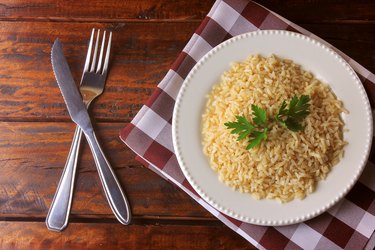
As far as grains go, rice is up there in terms of consumption. But when it comes to nutrition in jasmine rice vs. brown rice, the brown rice might make the healthier option. As a whole grain, your body utilizes the carbohydrate and protein content of brown rice more than white.
But you don't have to limit yourself to plain brown rice. If you like aromatic rice, jasmine rice makes a good option, especially if you find it in the brown rice variety.
Video of the Day
Video of the Day
Read more: How is White Rice Healthy for Our Body?
Compare the Number of Calories
Whether it's brown or white, jasmine or plain, it all has about the same calories. One-fourth cup of dry or 3/4 cup of cooked brown rice contains 160 calories while the same amount of jasmine rice contains 180 calories, according to the USDA.
With approximately 1 calorie per gram, both the brown and jasmine rice are low-energy-dense foods and make a good choice for those watching their weight. Low-energy-dense foods fill you up on fewer calories and help you eat less.
Count Carbs and Fiber
The carb and fiber content in brown and jasmine rice varies. A 3/4-cup cooked serving of plain brown rice contains 35 grams of total carbs and 1 gram of fiber. The same serving of white jasmine rice contains 42 grams of carbs and zero grams of fiber. The brown version of jasmine rice contains 35 grams of carbs and 2 grams of fiber, according to the USDA.
The brown rice varieties make a healthier option because of their fiber content. Fiber helps to regulate bowel movements, lower cholesterol levels, moderate blood sugar levels and control appetite, according to the Mayo Clinic.
Consider Protein and Fat
When it comes to protein and fat, there are slight variations in both the brown rices and the white jasmine rice. A 3/4-cup serving of the plain brown rice contains 4 grams of protein and 0.5 grams of fat. The same serving of the white jasmine rice contains 3 grams of protein and zero grams of fat, while the brown jasmine rice contains 3 grams of protein and 1 gram of fat.
As a whole grain, the brown rice retains its germ, which is where the fat comes from. However, the germ also contains the majority of the rice's vitamins and minerals, according to Harvard T.H. Chan School of Public Health.
Read more: Which Rice is Healthiest for Consumption?
Get Your Vitamins and Minerals
Just like the fat, the germ in the brown rice is also a source of vitamins and minerals. White jasmine rice also provides vitamins and minerals but through fortification. Both the brown and jasmine rice help you meet your iron and B vitamin needs, both essential nutrients.
Iron is part of every cell in your body and is necessary for delivering oxygen to your muscles and organs, according to the National Institutes of Health Office of Dietary Supplements. The B vitamins help convert the carbohydrates in rice into energy, in additional to their role in forming red blood cells, according to U.S. National Library of Medicine.
- Harvard T.H. Chan School of Public Health: "Whole Grains"
- U.S. National Library of Medicine: "B Vitamins"
- Mayo Clinic: "Dietary Fiber: Essential for a Healthy Diet"
- National Institutes of Health Office of Dietary Supplements: "Iron"
- USDA FoodData Central: "Brown Rice"
- USDA FoodData Central: "Jasmine Rice"
- FoodData Central: "Brown Jasmine Rice"
Was this article helpful?
150 Characters Max
0/150
Thank you for sharing!
Thank you for your feedback!